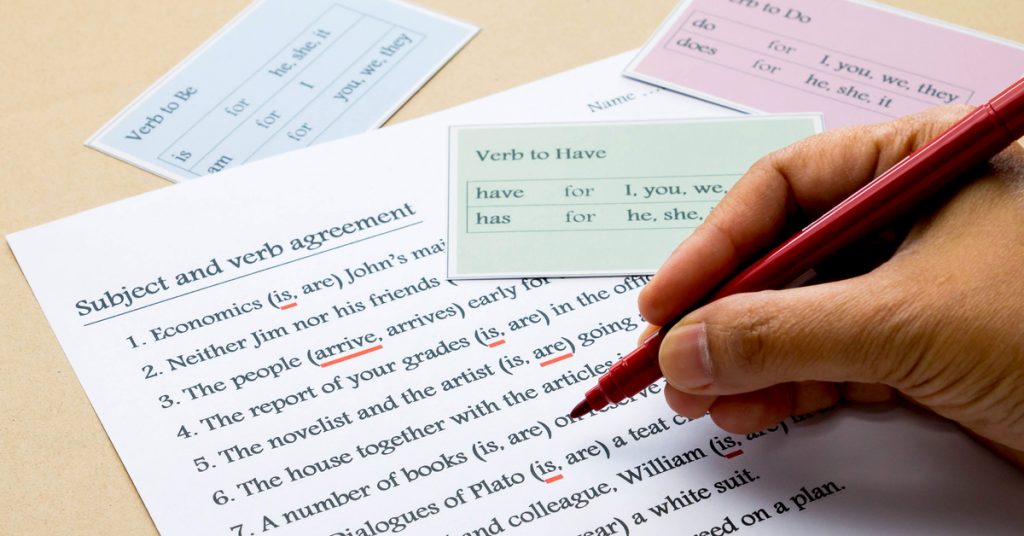Important SAT Update: Transition to Digital SAT
Effective December 3, 2023, the traditional paper-and-pencil format of the SAT has been discontinued. Starting in 2024, all students are required to take the Digital SAT, ushering in substantial changes in duration, format, material coverage, and question types. This shift to the Digital SAT represents a departure from traditional testing methods. It is crucial for students, educators, and test-takers to acquaint themselves with the new examination structure. Read more about the Digital SAT here.
These questions will ask you to assess whether the subjects and verbs agree. This rule’s basics are that singular subjects can only be tethered to a singular verb, and plural subjects can only be tethered to plural verbs.
Examples
Correct: The dog catches the ball.
The singular subject (a dog) is tethered to a singular form of catch. The subject and verb agree.
Incorrect: The dog catch the ball.
The singular subject (a dog) is tethered to a plural form of catch. The subject and the verb do not agree.
Correct: The dogs catch the balls.
The plural subject (dogs) is tethered to a plural form of catch. The subject and verb agree.
Incorrect: The dogs catches the balls.
The plural subject (dogs) is tethered to a singular form of catch. The subject and verb do not agree.
You will likely be able to assess their agreement by what sounds right. But, many forms of this question type are tricky and complicated.
Complications and Types of Errors to Look For
1. Descriptions and Interruptions
Some questions will present a flawed sentence with a phrase that deliberately breaks up a subject and a verb. With these sentences, it can be challenging to decipher what subject the verb is tethered to.
Like this:
My sister, who is studying biology, works in a lab.
The interrupting phrase to describe “my sister” complicates the assessment of subject-verb agreement. For questions like this, you can strategize by removing the descriptive clause.
My sister, who is studying biology, works in a lab.
It becomes clear that the subject-verb agreement in question is for “sister” and “works.” Without the descriptive clause, you can quickly assess errors between the subject and the verb. Avoid confusion with this question type by focusing on what the verb is acting on.
Many students will trip up on these questions by assuming that the subject closest to the verb is what should agree with the verb. Pay attention to these deliberate interruptions between a subject and verb.
2. Subject and Verb Sequence
When a subject comes after a verb, it can be challenging to pinpoint what the verb is meant to agree with. To answer these questions, you will have to focus on finding the subject affected by the verb.
For example:
Through the trees is a cottage.
The singular subject (cottage) agrees with the singular verb (is). This sentence could be tricky because your ear may think that “is” is tethered to “trees,” which would be a flaw in subject-verb agreement.
Here is another example showing subject-verb agreement with the subject after the verb.
Through the trees are five cottages.
The plural subject (cottages) is in agreement with the plural verb (are).
The best way to tackle these subject and verb sequence challenges is to pay attention to the subject and rearrange the sentence so that it comes first.
For the example above, you may rearrange the information like this:
There are five cottages through the trees.
By shifting the prepositional phrase “through the trees” to the end of the sentence, the subject-verb agreement is simplified and more accessible.
3. Compound Subjects and Collective Nouns
Other complications that could affect your assessment of subject-verb agreement are compound subjects.
Like this:
Sarah and Joe are farmers.
The verb is plural (“are”) because two singular subjects become one plural subject through “and.”
Collective nouns refer to a subject that is singular but refers to a group. Some examples are “team,” “group,” “squad,” “crew,” and “company.” Their effect on subject-verb agreement looks like this:
After living there for ten years, the family has decided to move.
The subject, “the family,” is a collective noun that refers to a group. The verb is singular to agree with the singular subject because the subject refers to one group of people.
Strategies to Solve these Questions
Keep track of the subject.
This is crucial. When you come across an underlined text, find the subject each verb is acting on. It can be easy to breeze past these errors, especially because the SAT® test makes them hard to find. Pay attention to the subject!
Note the interruptions.
Now that you know about interrupting phrases (like descriptions or prepositional phrases), keep an eye out for them. You can simplify the job of finding which subject is tethered to the verb by noting deliberate interruptions and complications within the sentence structure.
Recognize tricky rules.
Compound subjects and collective nouns are important to pay attention to. As you assess the underlined texts throughout the Writing test, note the subjects connected by “and,” and nouns that refer to a group.
You can practice these strategies and tips for subject-verb agreement questions in the Writing test by using UWorld’s SAT Prep course. Our practice exams, detailed question explanations, and performance tracking tools can provide you with experience and study tools. You can also find out about your weak points through these resources. Try them out to practice subject-verb agreement questions, and perfect your skills with these complicated questions.




